Comparison of Texas Instruments graphing calculators
A graphing calculator is a class of hand-held calculator that is capable of plotting graphs and solving complex functions. There are several companies that manufacture models of graphing calculators. Texas Instruments is a major manufacturer.
The following table compares general and technical information for a selection of common and uncommon Texas Instruments graphing calculators. See the individual calculators' articles for further information.
| Calculator | CPU | RAM | Display Size | Physical Size (inches) | Programming Languages | Link Ports | Year Released | Predecessors | Successors | Initial MSRP (nominal US$)[1] | Use on
College Board Standardized Tests[2] |
|---|---|---|---|---|---|---|---|---|---|---|---|
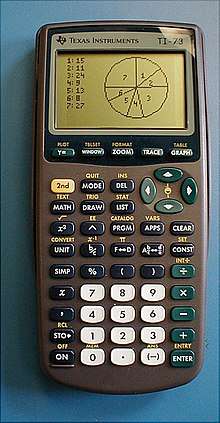 |
Zilog Z80 @ 6MHz | 25KB of RAM, 512KB of Flash ROM | 96×64 pixels 16×8 characters |
7.3 × 3.5 × 1.0[3] | TI-BASIC, Assembly (via Mallard), Flash Apps | I/O Port | 1998/2003 | TI-80 | None | 95 (TI-73) | Allowed |
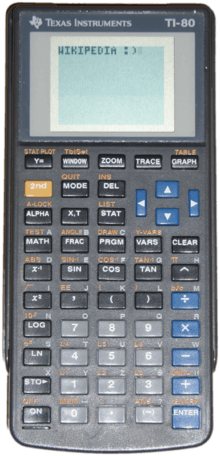 |
980 kHz Proprietary | 7 KB of RAM | 64×48 pixels 16×8 characters |
6.4 × 3.0 × 0.9[4] | TI-BASIC | None | 1995 | None | TI-73, TI-73 Explorer | Discontinued | Allowed |
 |
Zilog Z80 @ 2 MHz | 2.4 KB of RAM | 96×64 pixels 16×8 characters |
6.75 x 3.125 x 2.0 | TI-BASIC, Machine code (using an exploit and only on ROM 1.8K) | None | 1990 | None | TI-82 | 110 Discontinued |
Allowed |
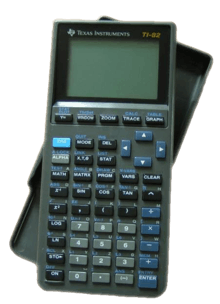 |
Zilog Z80 @ 6 MHz | 28 KB of RAM | 96×64 pixels 16×8 characters |
6.9 × 3.4 × 1.0[5] | TI-BASIC, Assembly (using exploits) | I/O Port | 1993 | TI-81 | TI-83 | Discontinued | Allowed |
 TI-83 |
Zilog Z80 @ 6 MHz | 32 KB of RAM | 96×64 pixels 16×8 characters |
7.3 × 3.5 × 1.0[6] | TI-BASIC, Assembly (built-in) | I/O Port | 1996 | TI-82 | TI-83 Plus | 125 Discontinued |
Allowed |
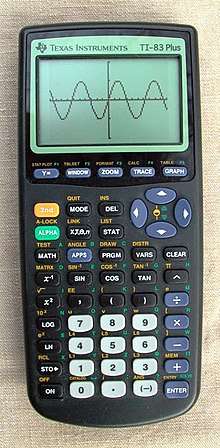 TI-83 Plus |
Zilog Z80 @ 6 MHz | 32 KB of RAM (24 KB user accessible), 512 KB of Flash ROM (160 KB user accessible) | 96×64 pixels 16×8 characters |
7.3 × 3.5 × 1.0[7] | TI-BASIC, Assembly (built-in), Flash Apps | I/O Port | 1999 | TI-83 | TI-83 Plus Silver Edition, TI-84 Plus | 104.99 | Allowed |
 |
Zilog Z80 @ 6 MHz/15 MHz (Dual Speed) | 128 KB of RAM (24 KB user accessible), 2 MB of Flash ROM (1.5 MB user accessible) | 96×64 pixels 16×8 characters |
7.3 × 3.5 × 1.0[8] | TI-BASIC, Assembly (built-in), Flash Apps | I/O Port | 2001 | TI-83 Plus | TI-84 Plus Silver Edition | 129.95 Discontinued |
Allowed |
 |
Zilog Z80 @ 15 MHz | 128/48 KB of RAM (24 KB user accessible), 1 MB of Flash ROM (480 KB user accessible) | 96×64 pixels 16×8 characters |
Unknown | TI-BASIC, Assembly (built-in), Flash Apps | I/O Port, Mini-USB Port | 2004 | TI-83 Plus | TI-84 Plus Silver Edition, TI-Nspire | Allowed | |
| Zilog Z80 @ 15 MHz | 128/48 KB of RAM (24 KB user accessible), 2 MB of Flash ROM (1.5 MB user accessible) | 96×64 pixels 16×8 characters |
Unknown | TI-BASIC, Assembly (built-in), Flash Apps | I/O Port, Mini-USB Port | 2004 | TI-83 Plus Silver Edition, TI-84 Plus | TI-Nspire, TI-84 Plus C Silver Edition | Allowed | ||
 |
Zilog Z80 @ 15 MHz | 128 KB of RAM (21 KB user accessible), 4 MB of Flash ROM (3.5 MB user accessible) | 320×240 pixels 26×10 characters (large font) |
Unknown | TI-BASIC, Assembly (built-in), Flash Apps | I/O Port, Mini-USB Port | 2013 | TI-84 Plus Silver Edition | TI-84 Plus CE | 150 Discontinued |
Allowed |
.jpg) |
Zilog eZ80 @ 48 MHz | 256 KB of RAM (154 KB user accessible), 4 MB of Flash ROM (3 MB user accessible) | 320×240 pixels 26×10 characters (large font) |
7.6 × 3.4 × 0.75 | TI-BASIC, Assembly (built-in) | Mini-USB Port | 2015 | TI-84 Plus C Silver Edition | None | 150 | Allowed |
 |
Zilog Z80 @ 6 MHz | 28 KB of RAM | 128×64 pixels 21×8 characters |
6.875 x 3.31 x 0.938 | TI-BASIC, Assembly (using exploits) | I/O Port | 1992 | None | TI-86 | 130 Discontinued |
Allowed |
 |
Zilog Z80 @ 6 MHz | 128KiB of RAM | 128×64 pixels 21×8 characters |
7.3 × 3.5 × 1.0[9] | TI-BASIC, Assembly (built-in) | I/O Port | 1997 | TI-85 | None | 150 Discontinued |
Allowed |
 |
Motorola 68000 @ 10 MHz/12 MHz (nominal) | 256 KiB of RAM (188 KB user accessible), 2 MiB of Flash ROM | 160×100 pixels | 7.3 × 3.5 × 1.0[10] | TI-BASIC, Assembly (built-in), Flash Apps | I/O Port | 1998 | TI-92, TI-92 II | TI-89 Titanium | 159.99 Discontinued |
Allowed |
 |
Motorola 68000 @ ≤16 MHz | 256 KiB of RAM (188 KB user accessible), 2.7 MB of Flash ROM | 160×100 pixels | Unknown | TI-BASIC, Assembly (built-in), Flash Apps | I/O Port, Mini-USB Port | 2004 | TI-89 | TI-Nspire CAS | 149.99 | Allowed |
TI-92, TI-92 II |
Motorola 68000 @ 10 MHz | 68 KB of RAM/136 KB of RAM | 240×128 pixels | Unknown | TI-BASIC, Assembly (using exploits) | I/O Port | 1995/1996 | None | TI-89, TI-92 Plus | 200 (TI-92) Discontinued |
Banned due to QWERTY keyboard |
TI-92 Plus |
Motorola 68000 @ 12 MHz | 256 KB of RAM (188 KB user accessible), 384 KB of Flash ROM | 240×128 pixels | 4.7 × 8.2 × 1.5[11] | TI-BASIC, Assembly (built-in), Flash Apps | I/O Port | 1998 | TI-92, TI-92 II | Voyage 200 | 179.99 Discontinued |
Banned due to QWERTY keyboard |
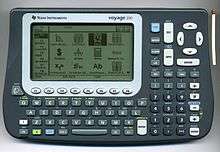 |
Motorola 68000 @ 12 MHz | 256 KB of RAM (188 KB user accessible), 2.7 MB of Flash ROM | 240×128 pixels | 4.6 × 7.3 × 1.2[12] | TI-BASIC, Assembly (built-in), Flash Apps | I/O Port | 2002 | TI-92 Plus | TI-Nspire CAS | Banned due to QWERTY keyboard | |
| ARM9 @ 90 MHz/120 MHz | 16 MB RAM, 20 MB of Flash ROM | 320×240 pixels (16-shade grayscale) | 7.90625 × 3.9375 × 0.96875 | TI-BASIC, Assembly (using exploits), Lua (with OS version 3.0.1 and greater) | Mini-USB port | 2007 | TI-84 Plus, TI-89 | TI-Nspire CX, TI-Nspire CX CAS | 149 (CAS: 159) | Allowed | |
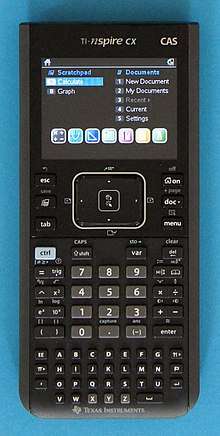 |
132 MHz[13] ARM9 | 64 MB of RAM, 100 MB of Flash ROM | 320×240 pixels (16-bit color) | 7.5625 × 3.59375 × 0.75 | TI-BASIC, Assembly (using exploits), Lua | Mini-USB port | 2011 | TI-Nspire, TI-Nspire CAS | None | 154.99 (CAS: 162.99) | Allowed |
| Calculator | CPU | RAM | Display Size | Physical Size | Programming Languages | Link Ports | Year Released | Predecessors | Successors | Initial MSRP (nominal US$)[1] | Use on
College Board Standardized Tests[2] |
Programming language support
| Calculator | TI-BASIC | Native code | Lua |
|---|---|---|---|
 TI-73, TI-73 Explorer | Yes | Yes | No |
 TI-80 | Yes | No | No |
 TI-81 | Yes | Only using exploits | No |
 TI-82 | Yes | Only using exploits | No |
 TI-83 | Yes | Yes | No |
 TI-83 Plus | Yes | Yes | No |
 TI-83 Plus Silver Edition | Yes | Yes | No |
 TI-84 Plus | Yes | Yes | No |
TI-84 Plus Silver Edition | Yes | Yes | No |
 TI-84 Plus C Silver Edition | Yes | Yes | No |
.jpg) TI-84 Plus CE | Yes | Yes | No |
 TI-85 | Yes | Only using exploits | No |
 TI-86 | Yes | Yes | No |
 TI-89 | Yes | Yes | No |
 TI-89 Titanium | Yes | Yes | No |
TI-92, TI-92 II | Yes | Only using exploits | No |
TI-92 Plus | Yes | Yes | No |
 Voyage 200 | Yes | Yes | No |
TI-Nspire, TI-Nspire CAS | Yes | Only using exploits | Yes |
 TI-Nspire CX, TI-Nspire CX CAS | Yes | Only using exploits | Yes |
See also
References
- 1 2 http://www.datamath.org/
- 1 2 "AP Central - AP Calculator Policy". apcentral.collegeboard.com. Retrieved 2017-05-13.
- ↑ "Size and Weight Specifications of Texas Instruments Graphing Calculators".
- ↑ "Size and Weight Specifications of Texas Instruments Graphing Calculators".
- ↑ "Size and Weight Specifications of Texas Instruments Graphing Calculators".
- ↑ "Size and Weight Specifications of Texas Instruments Graphing Calculators".
- ↑ "Size and Weight Specifications of Texas Instruments Graphing Calculators".
- ↑ "Size and Weight Specifications of Texas Instruments Graphing Calculators".
- ↑ "Size and Weight Specifications of Texas Instruments Graphing Calculators".
- ↑ "Size and Weight Specifications of Texas Instruments Graphing Calculators".
- ↑ "Size and Weight Specifications of Texas Instruments Graphing Calculators".
- ↑ "Size and Weight Specifications of Texas Instruments Graphing Calculators".
- ↑ http://www.omnimaga.org/news/nover-3-boost-your-nspire-with-the-automatic-overclocker/
This article is issued from
Wikipedia.
The text is licensed under Creative Commons - Attribution - Sharealike.
Additional terms may apply for the media files.